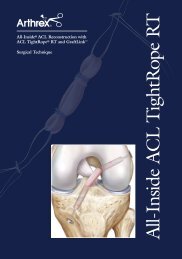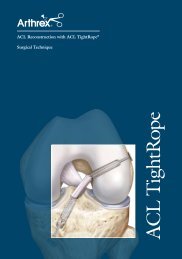Materials - Sumisan SA
Materials - Sumisan SA
Materials - Sumisan SA
Create successful ePaper yourself
Turn your PDF publications into a flip-book with our unique Google optimized e-Paper software.
306 A. WEILER ET AL.<br />
of biodegradable implants, such as sutures, staples,<br />
tacks, anchors, interference screws, and devices for<br />
meniscal repair. High mechanical properties of a<br />
biodegradable implant may be of primary importance<br />
in fracture fixation or other orthopaedic procedures<br />
where the implant is exposed to high loads. This may<br />
explain the slow progress of biodegradable implant<br />
technology in this field. In contrast, as several clinical<br />
and biomechanical studies have shown, certain operative<br />
procedures in sports medicine do not require<br />
implants of high mechanical strength. For interference<br />
screw fixation in cruciate ligament reconstruction,<br />
the cancellous bone may be the weak link and not the<br />
interference screw. 5-7 The fixation strength of a suture<br />
anchor construct may be limited by the suture or the<br />
bone stock quality. 8,9<br />
Biodegradable implants consist of different polymeric<br />
raw materials that have substantially different<br />
material characteristics and tissue response. We believe<br />
that it is inappropriate to apply the term biodegradable<br />
to all these different materials. Furthermore, it is<br />
important to know the basic biology of these materials,<br />
such as in vivo degradation, osseous replacement, and<br />
biocompatibility, in order to evaluate their appropriateness<br />
for the use in operative sports medicine. The<br />
purpose of this review is to focus on current developments<br />
and to provide the clinician with an insight in<br />
biodegradable implant biology.<br />
IN VIVO DEGRADATION<br />
Today, approximately 40 different biodegradable<br />
polymers are known. 10,11 Of these, the following<br />
materials have been studied to be used in orthopaedic<br />
implants:<br />
1. Polyglycolide (PGA) and copolymers such as polyglycolide-co-trimethylene<br />
carbonate (PGA-co-<br />
TMC), poly-(D,L-lactide-co-glycolide) (PDLLAco-PGA),<br />
and poly-(L-lactide-co-glycolide) (PLLAco-PGA).<br />
2. Poly-(L-lactide) (PLLA), poly-(D,L-lactide) (PDLLA),<br />
and their stereocopolymers with varying ratios of<br />
the L and D,L parts.<br />
3. Polydioxanone (PDS).<br />
4. Trimethylene carbonate (TMC).<br />
5. Polyorthoester (POE).<br />
6. Poly-c-capralacton (PCL).<br />
Additionally, composite materials consisting of<br />
PLLA/tricalcium phosphate or PLLA/hydroxyapatite<br />
have been introduced. 12-15 Of major interest in implant<br />
technology in the field of operative sports medicine are<br />
the poly-�-hydroxy acids such as PLLA and PGA<br />
including their copolymers and stereocopolymers. 16<br />
In principal, synthetic biodegradable polymers consisting<br />
of poly-�-hydroxy acids undergo an unspecific<br />
hydrolytic chain scission due to water uptake. 17 Degradation<br />
starts at the amorphous phase of the implant<br />
leading to fragmentation of the material to smaller<br />
parts, which are phagocytosed primarily by macrophages<br />
and polymorphonuclear leukocytes. 18-20 Polymeric<br />
lactic acid oligomers degrade to monomers<br />
which enter the Krebs cycle and get dissimilated to<br />
carbon dioxide and water. 17 Beside the hydrolytic<br />
chain scission, glycolic acid monomers can be released<br />
by unspecific esterases and carboxypeptidases. 21<br />
Degradation kinetics of different raw materials<br />
differ substantially, which may be attributable to the<br />
hydrophilic or hydrophobic nature of the different<br />
polymers. Furthermore, although the degradation kinetics<br />
of biodegradable implants depend primarily on<br />
polymer choice, a large variety of additional factors<br />
also appear to contribute to this process, including<br />
molecular weight, sterilization, implant size, selfreinforcement,<br />
and processing techniques. 11,22-30<br />
We know that in vitro hydrolysis testing could differ<br />
markedly from in vivo testing because of the additional<br />
influence of environmental conditions. Due to a<br />
possible interaction between degrading polymers and<br />
the healing tissue, the in vivo degradation characteristics<br />
of biodegradable implants should be known.<br />
Unfortunately, only a few studies have investigated the<br />
in vivo degradation of the different polymers used in<br />
biodegradable implants, and these have reported vastly<br />
different results because of inconsistent test conditions<br />
and different implant processing techniques. 11 Vert et<br />
al. 31 tested the tensile strength of different polylactides<br />
implanted in sheep tibiae. They reported that PLLA<br />
maintains its tensile strength for over 150 weeks. In<br />
contrast, Gerlach et al. 24 found that PLLA rods lose<br />
approximately 50% of their bending strength within 4<br />
weeks if implanted in rat dorsal muscles. Fischer et<br />
al. 14 reported that 2-mm rods made of PDLLA implanted<br />
in rat dorsal muscles maintained 90% of their<br />
initial bending strength for over 6 weeks with subsequent<br />
rapid degradation. In contrast, Mainil-Varlet et<br />
al. 32 reported that pushout forces of PDLLA rods<br />
implanted in sheep tibiae increased continuously over<br />
a period of 6 months and were significantly higher than<br />
those of PLLA rods. This may be the result of the<br />
implant swelling caused by water uptake of the<br />
stereocopolymer. In principal, it is reasonable to<br />
assume that slow or intermediate degrading materials<br />
such as PLLA, PLLA-co-PDLLA, or PDLLA maintain<br />
their mechanical strength at least for the time required




